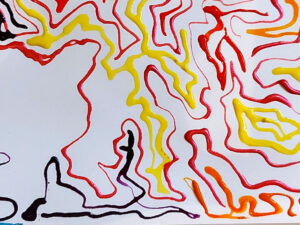
Featured Image: Day time. Night time. All time. by Leigh
05 Dec 2019
One of the bits of feedback my lecturer gave me after my formative 10-min presentation was “I want to see a definition of social change and I want it from someone other than you.” Fair enough. It had never occurred to me to define the terms I was using. In a way, she opened a flood gate for me and suddenly I was second guessing a lot of the words I was using – model, process map/chart? When I said those words was everyone thinking the same things I was? This is research, I’m pretty sure no one was. I’m fast coming to realise formal research is not my bag, but anyway… we should start somewhere so let’s start with Social Change. It’s the big term in my question. It brings up great videos in my YouTube search when combined with ‘art’ and ‘curation’. It’s the thing I’m trying to do so what exactly is it? Let’s hear from some experts.
“Social change is the significant alteration of social structure and cultural patterns through time. Social structure refers to persistent networks of social relationships where interaction between people or groups has become routine and repetitive.”
– Kevin T. Leicht, Professor and Head of the Sociology Department at the University of Illinois Urbana-Champaign (Leicht, 2019)
“Sociologists define social change as changes in human interactions and relationships that transform cultural and social institutions. These changes occur over time and often have profound and long-term consequences for society. Well known examples of such change have resulted from social movements in civil rights, women’s rights, and LBGTQ rights, to name just a few. Relationships have changed, institutions have changed, and cultural norms have changed as a result of these social change movements.”
– Theo Spanos Dunfey, Executive Director of Global Citizens Circle (Spanos Dunfey, 2019)
“The Appalachian Community Fund defines social change as the movement of people toward the establishment of environmental, economic, and social justice and the redistribution of wealth, power, and resources as indicated by evidence of:
and this next bit is the real kicker (love it!)
- Organizing and action led by people working to control their own lives;
- Educating communities about the root causes of oppression and injustice;
- Eliminating barriers to full participation in society ( i.e. racism, sexism, classism, homophobia, ageism, ablesim, and exclusion from decision-making processes);
- Focusing on efforts to change cultural, social, political, and economic systems and institutions that create, accommodate, and perpetuate social injustice;
- Creating and modeling democratic cultural, social, political, and economic systems;
- Connecting local issues with national and global concerns; and
- Networking, collaborating, and cooperating with other change agents working toward similar goals.”
– The Appalachian Community Fund (The Appalachian Community Fund, 2014)
These definitions seriously improved as I went along. The first one was pretty dry and academic. Accurate but impersonal and in no way conveying the impact or imperative of real social change. Very abstract. The second definition got me more excited. Yes! This organisation was talking my language, or so I thought until I hit upon the awesomeness that is The Appalachian Community Fund. This non-profit has the most take-no-prisoners, no-wiggle-room, we-want-results definition of social change I have ever come across. Their definition gets really specific. It’s not abstract, it’s not nebulous. It’s concrete, almost measurable. I almost want to call it a S.MA.R.T. definition, like S.M.A.R.T. goals (Doran, Miller and Cunningham, 1981). You will know when you attain this. Of course, we can get even more specific and slap numbers into this definition, but compared to the other two definitions, this is definitely top-notch. The evidence the ACF desire are the type of actions I hope my audience will rush out to participate in after they come to the exhibition. This is THE definition.
—
References
Leicht, K.T. (2019). Social Change. [online] Oxfordbibliographies.com. Available at: https://www.oxfordbibliographies.com/view/document/obo-9780199756384/obo-9780199756384-0047.xml [Accessed 16 Dec. 2019].
Spanos Dunfey, T. (2019). What is Social Change and Why Should We Care? [online] Snhu.edu. Available at: https://www.snhu.edu/about-us/newsroom/2017/11/what-is-social-change [Accessed 20 Dec. 2019].
The Appalachian Community Fund (2014). Social Change. [online] Appalachiancommunityfund.org. Available at: http://www.appalachiancommunityfund.org/social-change/ [Accessed 20 Dec. 2019].
Doran, G., Miller, A. and Cunningham, J. (1981). There’s a S.M.A.R.T. way to write management’s goals and objectives. Management Review, 70(11), pp.35–36. Available at: https://community.mis.temple.edu/mis0855002fall2015/files/2015/10/S.M.A.R.T-Way-Management-Review.pdf [Accessed 5 Dec. 2019].








